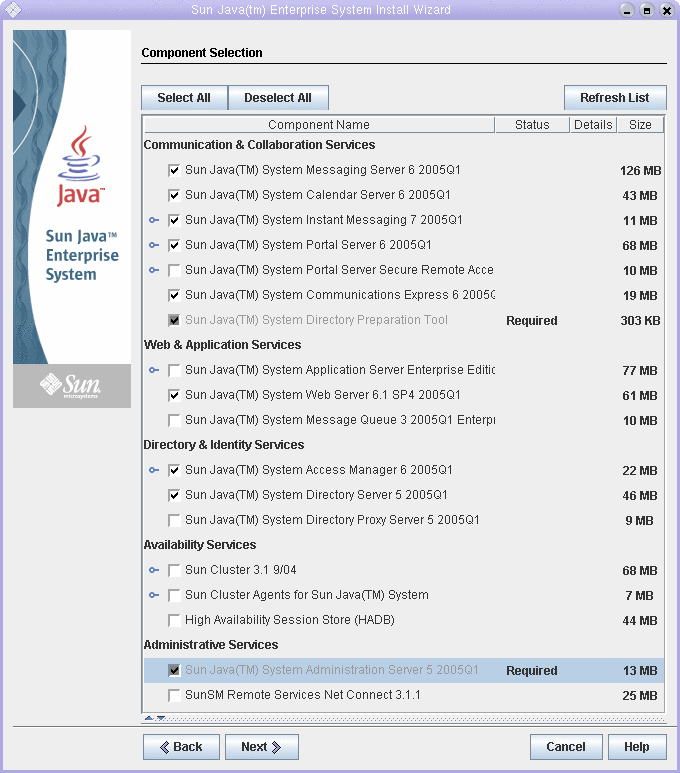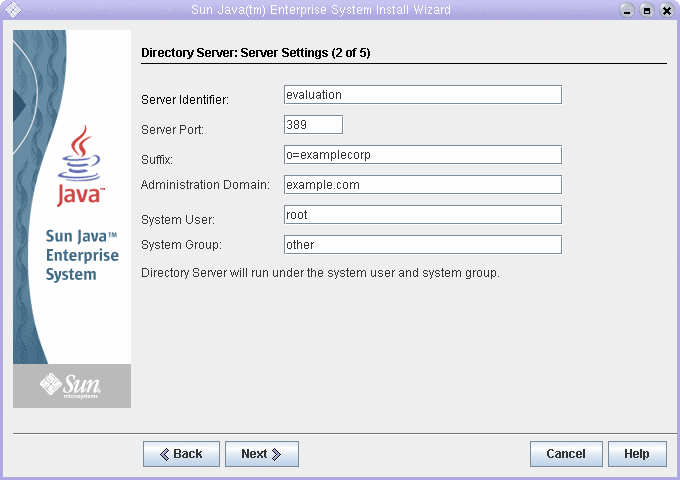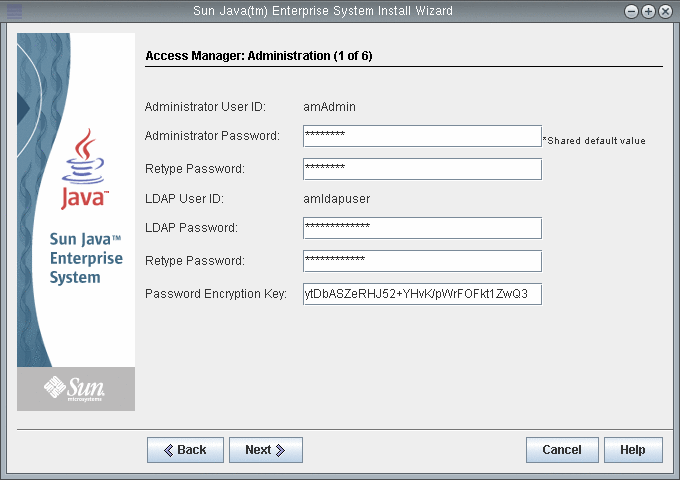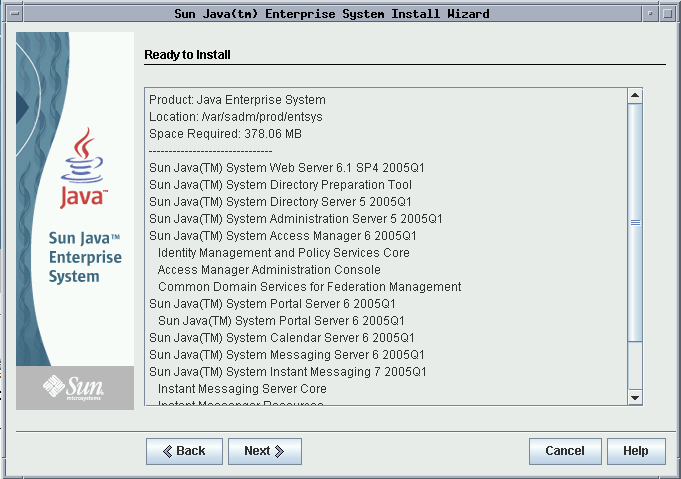Chapter 5 Installing the Components
This chapter describes how to install the components used in the evaluation solution. It covers copying the software distribution to the system on which you are installing, performing some necessary preliminary steps, and running the Java ES installer. When you run the installer you input the values you developed in the installation and configuration plan. (For a summary of the input values, see Java ES Installer Details.)
This chapter covers the installation process in the following sections:
Checking Installation Requirements
Before you run the installer, make sure the system on which you are installing meets the following requirements:
-
The system must meet the Java ES hardware, operating system, and patch requirements, which are listed in the Java Enterprise System Release Notes at http://download.oracle.com/817-5503. Patches are available at http://sunsolve.sun.com. The Java ES installer checks the system for these requirements, but you might find it easier to check the system before you begin.
-
You must run the installer as root. Ensure that you have root access to the system on which you are installing Java ES.
-
The installation procedures are for a system that is running a the SolarisTM 9 Operating System. If you install on the Solaris 8 Operating System, some path names will vary slightly from those shown in the instructions.
Preliminary Steps
This section describes two tasks you must perform before you run the installer. These tasks prepare your system for a successful installation.
 To Check the Internet Host Table
To Check the Internet Host Table
The system’s Internet host table must contain the system’s fully qualified host name.
Steps
-
Log in as root to the system on which you are installing Java Enterprise System.
-
Open the /etc/hosts file in a text editor.
-
Confirm that the /etc/hosts file contains the system’s fully qualified host name.
For example, on a system named evaluation.example.com, the /etc/host file includes the following lines:
# # Internet host table # 127.0.0.1 localhost 192.18.78.28 evaluation.example.com evaluation
The fully qualified version of the host name must precede the unqualified name. Your /etc/host file must include similar information for your system.
 To Disable the sendmail Process
To Disable the sendmail Process
The sendmail process can conflict with Java Enterprise System communications services. Disable it before you install Java Enterprise System.
Steps
-
Run the command to stop the sendmail process:
/etc/init.d/sendmail stop
-
Run the command to disable sendmail startup:
mv /etc/init.d/sendmail /etc/init.d/sendmail.disabled
Installing the Components
This section describes the procedures for running the Java ES installer. You use the installer input values developed in the evaluation installation and configuration plan. (For a summary of the values and explanations of why they were chosen, see Java ES Installer Details
Note –
Throughout this document you see commands that contain the variables evaluation_host and evaluation_domain. When you execute the commands you must substitute the host name or domain name of the computer system that you are using. These variables are defined as follows:
-
evaluation_host: The fully-qualified domain name of the system on which you are installing Java Enterprise System components. For example, if you are installing on a system named evaluation.example.com, your evaluation_host is evaluation.example.com. You use evaluation_host to configure communication between components. For example, you configure components to connect to Directory Server at evaluation_host:389. You also use evaluation_host in the URLs for web-based interfaces to Access Manager, Messaging Server, Calendar Server, and Portal Server.
-
evaluation_domain: The name of the DNS domain for the system on which you are installing components. For example, if you are installing on a system named evaluation.example.com, your evaluation_domain is example.com.
 To Begin the Installation Process
To Begin the Installation Process
Steps
-
Log in as root to the machine on which you are installing Java Enterprise System.
-
Obtain the Java ES 2005Q1 software by one of the following means:
-
Download the software from the Java Enterprise System site at http://www.sun.com . Create a directory for the software (download-directory). Download and unpack the software. Unpacking the software will create subdirectories of download-directory.
-
Run the installer from a CD or DVD. Put the CD or DVD in the appropriate drive.
-
-
Change directory to the platform-directory for the platform on which you are installing. The platform-directory is either Solaris_sparc or Solaris_X86.
-
If you downloaded and unpacked the software, the platform-directory is a sub directory of your download-directory:
cd download-directory/platform-directory
-
If you are running the installer from a CD, the platform-directory is a sub directory of your cdrom directory:
cd cdrom/platform-directory
-
If you are running the installer from a DVD, locate platform-directory on the DVD.
-
-
Run the command to start the Java Enterprise System installer.
./installer
The Welcome page is displayed.
-
Click Next.
The Software License Agreement page is displayed.
-
Click Yes, Accept License.
The Language Support page is displayed.
-
Select the languages other than English that you want to support in your evaluation solution. English is always supported.
Click Next. The Component Selection page is displayed.
Figure 5–1 Component Selection Page

 To Select Components for Installation
To Select Components for Installation
Steps
-
Select the components that are used in the evaluation solution. Do the following:
-
Select Sun Java System Messaging Server 6 2005Q1
-
Select Sun Java System Calendar Server 6 2005Q1
-
Select Sun Java System Instant Messaging 7 2005Q1
-
Select Sun Java System Portal Server 6 2005Q1
-
Select Sun Java System Communications Express 6 2005Q1
-
Sun Java System Directory Preparation Tool is automatically selected
-
Select Sun Java System Web Server 6.1 SP4 2005Q1
-
Sun Java System Access Manager 6 2005Q1 is automatically selected
-
Sun Java System Directory Server 5 2005Q1 is automatically selected
-
Sun Java System Administration Server 5 2005Q1 is automatically selected
These selections are shown in Figure 5–1. Click Next. The installer validates your selections and checks for compatibility between the components you select and the software that is already installed on the system. You see a page that describes the result of the compatibility checks.
-
-
Evaluate the installer’s response to your selections.
The installer checks for three types of compatibility. Depending on your system, you see none, one, two, or three of the following pages that report incompatibilities.
-
The installer might determine that the components you selected are not compatible with components already on the system.
You see the Product Dependency Checks dialog box shown in Figure 5–2.
Figure 5–2 Product Dependency Checks Dialog Box

You must resolve the incompatibility described in the dialog box before you can continue. In some cases, you must exit the installer, upgrade or remove the incompatible software, and then restart the installer from the beginning.
-
The installer might determine that the JavaTM 2 Software Development Kit, Standard Edition (J2SETM SDK) that is already installed on the system is not compatible with the components that you selected for installation.
You see the J2SE Software Development Kit Upgrade Required page.
Click OK to accept the default value (Install a Second J2SE SDK for Sun Java(TM) Enterprise System Components).
-
The installer might determine that the shared components already installed on the system are not compatible with the components that you selected for installation.
You see the Shared Components Upgrades Required page shown in Figure 5–3.
Figure 5–3 Shared Components Upgrades Required Page

Click Next to upgrade the shared components.
Note –Shared components provide local services and technology support for Java ES components. When you install Java ES, the installer automatically installs the shared components that are required by the Java ES components you selected.
-
The installer might determine that your system is fully compatible with the components you selected. The Installation Directories page is displayed.
-
-
Click Next to accept the default installation directories.
The Verify System Requirements page is displayed.
-
Wait while the Verify System Requirements page checks your system against the following system requirements:
-
Disk space
-
Memory
-
Operating system patches
-
Operating system resources
-
-
Evaluate the result of the system requirements checks.
-
Ignore a low memory warning. The evaluation solution requires less memory than a production solution.
-
If you receive a patch warning you must close the installer, install the patch, and then restart the installer from the beginning.
When the system check is satisfactory, click Next. The Configuration Type Panel page is displayed.
-
 To Select a Configuration Type
To Select a Configuration Type
Steps
-
Select Configure Now.
Configure Now lets you supply configuration values for most of the components you install. The installer configures the components according to the values that you supply in the installer pages.
Click Next. The Custom Configuration page is displayed.
-
Review the list of components that the installer cannot configure.
The message explains that the Java ES installer does not configure Directory Preparation Tool, Instant Messaging, Calendar Server, Messaging Server, or Communications Express. Chapter 6, Configuring and Verifying the Components describes how to configure Calendar Server, Messaging Server, and Instant Messaging and Communications Express.
Click Next. The Common Server Settings page is displayed.
Figure 5–4 Common Server Settings Page

 To Supply Common Server Settings
To Supply Common Server Settings
Step
-
For Host Name, accept the default value.
-
For DNS Domain Name, accept the default value.
-
For Host IP Address, accept the default value.
-
For Administrator User ID, accept the default value.
-
In the Administrator Password text field type password.
-
In the Retype Password text field, type password.
-
For System User, accept the default value.
-
For System Group, accept the default value.
Supply values that are used to configure all the components that are configured by the installer. Do the following:
Note –
The default values for Host Name, DNS Domain Name, and Host IP Address are derived from the system on which you are installing.
Figure 5–4 shows the default values for a system named evaluation.example.com. The Host Name field is the system name, evaluation, and the DNS Domain Name field is example.com . You see similar values for the system on which you are installing.
Click Next. The Web Server: Administration (1 of 2) page is displayed.
 To Supply Web Server Configuration Values
To Supply Web Server Configuration Values
Steps
-
Click next to accept the default values.
The Web Server: Default Web Server Instance (2 of 2) page is displayed.
Figure 5–5 Web Server: Default Web Server Instance (2 of 2)

-
Do the following:
-
In the Runtime User ID text field, type root.
-
In the Runtime Group text field, type other.
-
Select Automatically Start Web Server When System Restarts.
Click Next. The Directory Server: Administration (1 of 5) page is displayed.
Tip –The user and group that you specify forWeb Server must be the same user and group you are using for the components that run in Web Server.
-
 To Supply Directory Server Configuration Values
To Supply Directory Server Configuration Values
Steps
-
Click Next to accept the default values.
Tip –The Administrator Password and Directory Manager Password text fields display asterisks. The values in these text fields are the default password you specified on the Common Server Settings page, which is password.
The Directory Server: Server Settings (2 of 5) page is displayed.
Figure 5–6 Directory Server: Server Settings (2 of 5)

-
Do the following to establish your directory tree’s base suffix.
-
In the Server Identifier text field, confirm that default value is the unqualified form of your evaluation_host. For example, if you are installing on a system named evaluation.example.com, the default Server Identifier is evaluation.
-
In the Server Port text field, accept the default value of 389.
-
In the Suffix text field, type o=examplecorp. This value specifies the base suffix of the evaluation solution’s directory tree.
-
In the Administration Domain text field, accept the default value of evaluation_domain.
-
In the System User text field, accept the default value of root.
-
In the System Group text field, accept the default value of other.
Tip –The Server Identifier identifies your server instance in the Directory Server console.
Click Next. The Directory Server: Configuration Directory Server (3 of 5) page is displayed.
-
-
Click Next to accept the default value.
The Directory Server: Data Storage Location (4 of 5) page is displayed.
-
Click Next to accept the default value.
The Directory Server: Populate Data (5 of 5) page is displayed.
-
Click Next to accept the default value.
Tip –The default selection in this page (the Sample Data radio button under the Populate With Data checkbox) ensures that the installer will populate your LDAP database with sample data.
The Administration Server: Server Settings (1 of 2) page is displayed.
 To Supply Administration Server Configuration Values
To Supply Administration Server Configuration Values
Steps
-
Click Next to accept the default values.
The Administration Server: Configuration Directory Settings (2 of 2) page is displayed.
-
Click Next to accept the default values.
The Access Manager: Administration (1 of 6) page is displayed.
Figure 5–7 Access Manager: Administration Page

 To Supply Access Manager Configuration Values
To Supply Access Manager Configuration Values
Steps
-
Do the following:
-
In the Administrator Password and Retype Password text fields, accept the default value.
Tip –The Administrator Password displays asterisks. The value in this text field is the default password, password.
-
In the LDAP Password and Retype Password text fields, type ldappassword.
Tip –The LDAP password cannot be the same as the Administrator password.
Click Next. The Access Manager: Web Container (2 of 6) page is displayed.
-
-
Click Next to accept the default value.
The Access Manager: Sun Java System Web Server (3 of 6) page is displayed.
-
Click Next to accept the default values.
The Access Manager: Web Container for Running Identity Server Services (4 of 6) page is displayed.
-
Click Next to accept the default values.
The Access Manager: Directory Server Information (5 of 6) page is displayed.
-
Click Next to accept the default values.
The Access Manager: Directory Server Information (6 of 6) page is displayed.
-
Click Next to accept the default value.
The Portal Server: Web Container page is displayed.
 To Supply Portal Server Configuration Values
To Supply Portal Server Configuration Values
Steps
-
Click Next to accept the default value.
The Portal Server: Sun Java System Web Server page is displayed.
-
Click next to accept the default values.
The Portal Server Web Container Deployment page is displayed.
-
Click Next to accept the default values.
Tip –Install Sample Portal is selected by default. Installing the sample portal provides a portal desktop that you can use without developing your own portal desktop.
The Ready to Install page is displayed.
Figure 5–8 Ready to Install Page

 To Complete the Installation
To Complete the Installation
Steps
-
Review the list of components to be installed. The list should match Figure 5–8.
-
If you want to review your input or make changes, click Back. You can go back to any installer page and change any value.
-
If you are ready to install, click Next. The installer upgrades the shared components. This process takes a few minutes. When the installer finishes upgrading shared components, the Product Registration page is displayed.
-
-
In the Product Registration page, clear Open Registration Window During Installation, and then click Install.
The Installing page is displayed. The installation process takes a few minutes. When the installation is finished, the Installation Complete page is displayed.
-
Click View Summary and confirm that all components were installed correctly.
The installation process is complete.
-
Click Close to exit from the installer.
Tip –After you complete the evaluation, you can uninstall the components. For uninstallation procedures, see Uninstalling the Components.
Reviewing the Installation Log Files
If you are interested in the details of the installation, you can review the installation log files. This section describes how to locate the log files.
 To Review the Installation Log Files
To Review the Installation Log Files
Steps
-
Change directory to the log file directory:
cd /var/sadm/install/logs
-
Run the ls command to list the contents of the directory:
ls
You see a list of installation log files for the components you installed.
-
Open any of the installation log files you are interested in.
For example, the installation log file for Directory Server has a file name that includes a date stamp. It resembles Directory_Server_install.B mmdd9999.
Tip –The following log file contains information about the dependency checking performed by the installer:
/var/sadm/install/log/installdependencies.txt
- © 2010, Oracle Corporation and/or its affiliates
